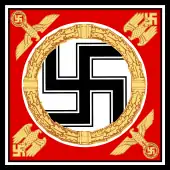Flag of Nazi Germany
The flag of Nazi Germany, officially the flag of the German Reich, featured a red flag with the swastika on a white disc. This flag came into use initially as the banner of the National Socialist German Workers' Party (NSDAP) after its foundation. Following the appointment of Adolf Hitler as Chancellor in 1933, the flag was adopted as the one of the nation's dual national flags, the other being the black-white-red horizontal tricolour of the German Empire.
.svg.png.webp) | |
| Name | Nazi flag, Swastika flag |
|---|---|
| Use | National flag and ensign |
| Proportion | 3:5 |
| Adopted | 1935 |
| Design | A horizontal red flag with the black swastika on the white circle |
One year after the death of President Hindenburg in 1934, this arrangement ended and the swastika flag became the national flag of Germany in 1935, which it remained until the end of World War II and the fall of the Third Reich.
History
Origins
.svg.png.webp)
After rejecting many suggestions and colours, the process of choosing a new flag,
"I myself, meanwhile, after innumerable attempts, had laid down a final form; a flag with a red background, a white disk, and a black swastika in the middle. After long trials I also found a definite proportion between the size of the flag and the size of the white disk, as well as the shape and thickness of the swastika."
— Adolf Hitler, Mein Kampf (1925)
Following the Nazi Party seizing control of the country on 30 January 1933, the black-red-gold tricolour flag was discarded; a ruling on 12 March established two legal national flags: the reintroduced black-white-red imperial tricolour and the flag of the Nazi Party.[1][2]
Nazi ensigns had a through and through image, so the "left-facing" and "right-facing" version were each present on one side. However, the Nazi flag on land was right-facing on both sides.[lower-alpha 1]
Albert Speer, in his book Inside the Third Reich, stated that: "in only two other designs did he (Adolf Hitler) execute the same care as he did his Obersalzberg house: that of the Reich War Flag and his own standard of Chief of State", showing that Hitler was an avid vexillographer (flag designer).
An off-centred disk version of the swastika flag was used as the civil ensign on German-registered civilian ships and was used as the Jack on Kriegsmarine warships. There is debate as to whether the off-centred disk flag was the official national flag from 1935 to 1945, such as at the popular vexillogy site, Flags of the World.[4] References from Third Reich books that display the country's flags always show the centred-disk version as Germany's national flag. One book published by the Third Reich in 1937, Du bist Sofort im Bilde ('You Are Informed Immediately', a guide book to the organization of the Third Reich) displays a centred-disk German flag as Germany's national flag.[5] A book published one year earlier in 1936 in the Third Reich, Deutscher Beamten-Kalender 1936 ('German Civil Servants Yearbook 1936') also displays the centred-disk flag as the national flag, beside it the off-centred disk flag is described for use on a "Kriegsschiff" (warship).[6] Also the centred-disk flag was commonly used by civilians and the German armed forces aside from the navy.
.jpg.webp)
From 1933 to at least 1938 in Nazi Germany, before any official swastika flag went into use, it had to be put into a ceremony where it touched the "Blutfahne" or Blood flag, the swastika flag used by Nazi paramilitaries during the failed Beer Hall Putsch in 1923. This lengthy ceremony took place at every Nuremberg Rally. It is unknown whether this tradition was continued after the last Nuremberg rally in 1938.
Since 1945
_crop.jpg.webp)
At the end of World War II, after the fall of the Third Reich, the first law enacted by the Allied Control Council abolished all symbols and repealed all relevant laws of the Reich.[7] The possession of swastika flags is forbidden in several countries since then, with the importation or display of them forbidden particularly in Germany.
Today, the Third Reich flag remains in common use by neo-Nazi supporters and Nazi sympathisers.
Gallery
.svg.png.webp) Flag of the Nazi Party
Flag of the Nazi Party Standard of Adolf Hitler
Standard of Adolf Hitler Flag of the Wehrmacht Commander in Chief (replaced the Minister of Defence)
Flag of the Wehrmacht Commander in Chief (replaced the Minister of Defence) Flag of the Schutzstaffel (SS)
Flag of the Schutzstaffel (SS) Flag of the Ordnungspolizei (OrPo) ("Order Police", the national regular police organization of Nazi Germany)
Flag of the Ordnungspolizei (OrPo) ("Order Police", the national regular police organization of Nazi Germany) Flag of the Hitler Youth
Flag of the Hitler Youth
See also
Notes
- As in the image, at the bottom[3]
References
- von Hindenburg, Paul (12 March 1933). "Erlaß des Reichspräsidenten über die vorläufige Regelung der Flaggenhissung" [Decree of the President for the provisional regulation of raising flags]. documentArchiv.de (in German). Retrieved 17 July 2010.
- Fornax. "The German Swastika Flag 1933–1945". Historical flags of our ancestors. Retrieved 17 July 2010.
- http://flagspot.net/flags/de1933_o.html
- http://www.flags-of-the-world.net/flags/de1933_o.html
- http://www.od43.com/Sofort_im_Bilde_1937.html
- http://www.od43.com/RDB_Yearbook_1936.html
- Allied Control Council (30 August 1945). "Law N° 1 from the Control Council for Germany: Repealing of Nazi Laws". European Navigator. Retrieved 23 December 2007.
